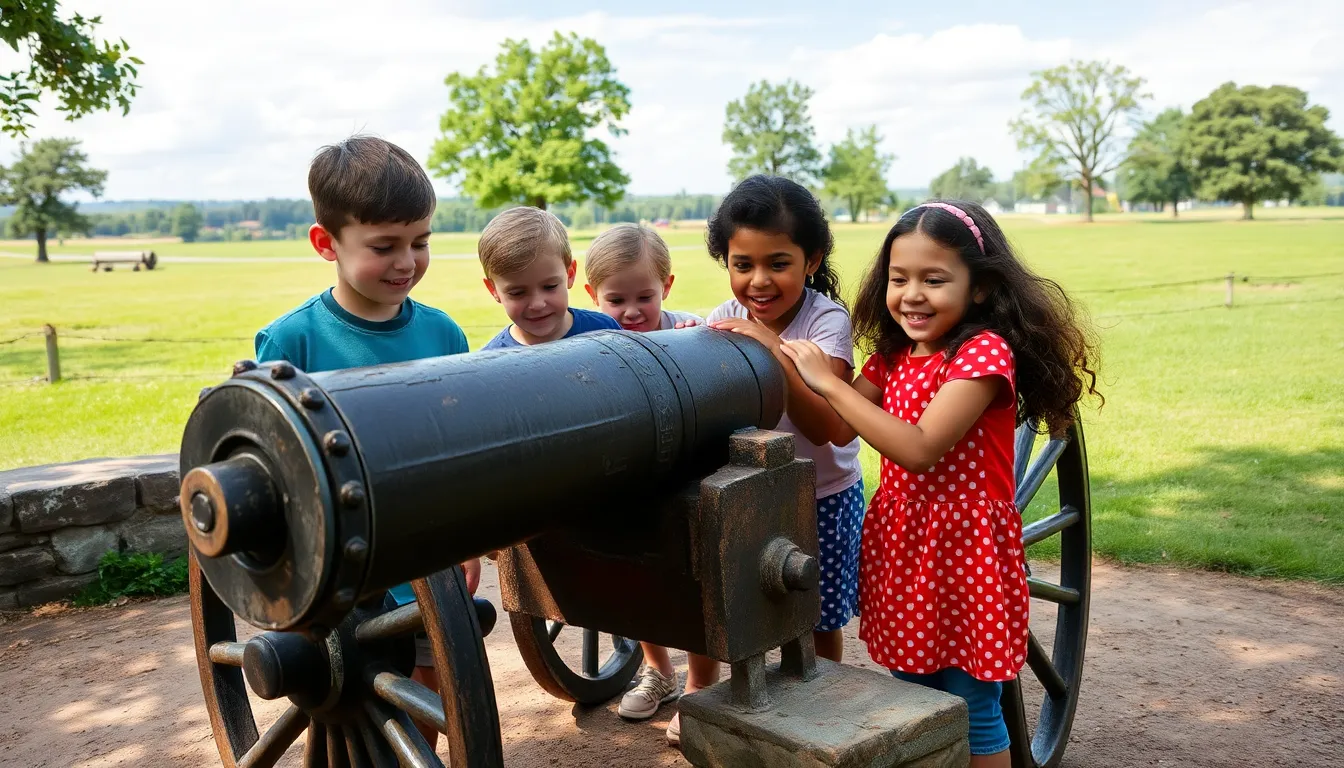Exploring historic sites can be like stepping into a time machine for kids. Imagine them wandering through ancient ruins, feeling like mini archaeologists on a quest for treasure! These adventures not only spark their imagination but also sneak in some valuable lessons about history and culture. Who knew learning could be this much fun?
Table of Contents
ToggleWhat Are Historic Sites For Kids?
Historic sites for kids represent unique opportunities for interactive learning. These locations, rich in history, engage children in the stories behind various cultures. Sites like museums, battlefields, and ancient ruins provide firsthand experiences that textbooks cannot replicate. Children encounter tangible objects and learn in a stimulating environment, enhancing their understanding of the past.
Visiting these sites can spark curiosity and foster a love for learning. Activities such as guided tours, scavenger hunts, and hands-on exhibits make history come alive for young minds. Engaging with knowledgeable staff also allows kids to ask questions and deepen their understanding.
Common examples of historic sites include local landmarks, national parks, and preserved homes. These locations often host educational programs tailored specifically for children. Programs might include reenactments, workshops, and interactive displays that make learning more enjoyable.
Families can also benefit from visiting historic sites together. Parents can share personal stories and connections to history, enriching the experience for their children. Exploring as a family creates lasting memories and encourages discussions about the past.
Exploring historic sites promotes critical thinking and problem-solving skills. Children learn to observe details, form conclusions, and appreciate different perspectives. These visits cultivate a sense of wonder and respect for history, ensuring that the lessons learned stick with them for years to come.
Importance Of Visiting Historic Sites

Visiting historic sites enriches children’s understanding of the past, fostering a deeper appreciation for history and culture. It provides an engaging way to learn through real-life experiences.
Educational Benefits
Experiencing historic sites enhances children’s education by offering hands-on learning opportunities. Kids absorb information better when they interact with their surroundings. Official tours often include knowledgeable guides who share fascinating stories beyond textbook facts. Engaging activities, like scavenger hunts, reinforce learning while making it fun. Historic sites frequently host educational programs tailored for younger audiences, increasing retention of lessons learned. Visiting places like battlefields or preserved homes highlights important events, helping kids connect emotionally with history.
Inspiring Curiosity
Exploring new environments sparks children’s curiosity about the world. Historic sites allow kids to ask questions and seek answers, expanding their desire for knowledge. Seeing artifacts from different cultures encourages them to think critically and imagine life in the past. Conversations often arise during family visits, leading to deeper discussions about society and changes over time. These interactions inspire creativity, driving children to explore further beyond what they learn in school. Historic sites cultivate a lifelong interest in learning and exploration, shaping well-rounded individuals.
Best Historic Sites For Kids
Exploring historic sites offers kids unique experiences that deepen their understanding of history. These places combine education with fun, making learning memorable.
Interactive Museums
Interactive museums stand out as exceptional destinations for kids. They encourage hands-on participation through exhibits designed to engage young minds. Activities like building models, experimenting with science, and role-playing historical figures captivate attention. Notable examples include the Exploratorium in San Francisco and the Museum of Science and Industry in Chicago. Both locations feature engaging experiences that invite kids to learn through exploration. Children engage with history and science, blending fun with education seamlessly. These museums often host workshops and guided tours, further enhancing the learning experience.
Landmark Historical Locations
Landmark historical locations provide kids a glimpse into significant events and cultures. Famous sites include Independence Hall in Philadelphia and the Alamo in San Antonio. Each location tells a unique story, revealing the past’s impact on the present. Children can visualize history through preserved buildings and artifacts. Tours often feature interactive elements, such as reenactments and storytelling, which captivate young visitors. Many landmarks offer educational programs specifically designed for children, making learning accessible. These locations foster an appreciation for heritage and inspire curiosity about the world.
Tips For Visiting Historic Sites With Kids
Visiting historic sites with children requires thoughtful planning and engaging activities. Taking the time to prepare makes the experience enjoyable and educational.
Planning Ahead
Researching each site ahead of time enhances excitement. Check for age-appropriate tours or programs tailored for kids. Knowing the schedule for guided tours and special events can maximize engagement. Make sure to pack essentials like water, snacks, and sun protection. Dress comfortably for walking and weather changes, as many sites involve outdoor exploration. Discuss the visit with children in advance, encouraging questions and interests related to history. Setting expectations about site rules fosters respect and enhances the overall experience for everyone.
Engaging Activities
Incorporating interactive elements keeps kids engaged throughout the visit. Look for scavenger hunts organized by the site, which provide fun ways to discover stories behind exhibits. Consider assigning roles so children can actively participate in tours by asking questions. Many historic sites offer hands-on experiences, such as workshops or reenactments, that captivate their attention. Encourage kids to take photos or keep a journal documenting discoveries during the visit, reinforcing learning. Completing these activities creates valuable connections to history and culture, transforming an ordinary trip into an unforgettable adventure.
Exploring historic sites opens a world of discovery for children. These adventures not only make history tangible but also spark curiosity and creativity. By engaging in interactive activities and guided tours, kids develop a deeper understanding of the past while enjoying memorable experiences with family.
The lessons learned during these visits extend beyond the classroom, fostering critical thinking and a love for learning. As children explore different cultures and significant events, they cultivate an appreciation for history that lasts a lifetime.
Ultimately, visiting historic sites transforms education into an exciting journey, laying the foundation for informed and curious individuals ready to explore the world around them.





